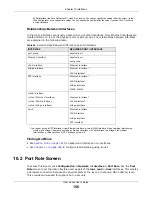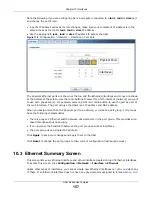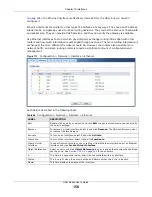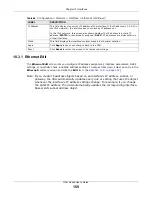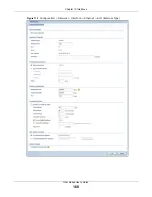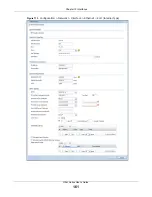
Chapter 9 Wireless
UAG Series User’s Guide
146
9.5 Load Balancing
Use this screen to configure wireless network traffic load balancing between the APs on your
network. Click
Configuration > Wireless > Load Balancing
to access this screen.
Figure 102
Configuration > Wireless > Load Balancing
Each field is described in the following table.
Table 61
Configuration > Wireless > Load Balancing
LABEL
DESCRIPTION
Enable Load
Balancing
Select this to enable load balancing on the UAG.
Mode
Select a mode by which load balancing is carried out.
Select
By Station Number
to balance network traffic based on the number of specified
stations connect to an AP.
Select
By Traffic Level
to balance network traffic based on the volume generated by the
stations connected to an AP.
Once the threshold is crossed (either the maximum station numbers or with network
traffic), then the AP delays association request and authentication request packets from
any new station that attempts to make a connection. This allows the station to
automatically attempt to connect to another, less burdened AP if one is available.
Max Station
Number
Enter the threshold number of stations at which an AP begins load balancing its
connections.
Traffic Level
Select the threshold traffic level at which the AP begins load balancing its connections
(low, medium, high).
Disassociate
station when
overloaded
Select this option to disassociate wireless clients connected to the AP when it becomes
overloaded. If you do not enable this option, then the AP simply delays the connection
until it can afford the bandwidth it requires, or it transfers the connection to another AP
within its broadcast radius.
The disassociation priority is determined automatically by the UAG and is as follows:
•
Idle Timeout
- Devices that have been idle the longest will be disassociated first. If
none of the connected devices are idle, then the priority shifts to
Signal Strength
.
•
Signal Strength
- Devices with the weakest signal strength will be disassociated first.
Note: If you enable this function, you should ensure that there are multiple APs within the
broadcast radius that can accept any rejected or kicked wireless clients; otherwise, a
wireless client attempting to connect to an overloaded AP will be kicked continuously
and never be allowed to connect.

























